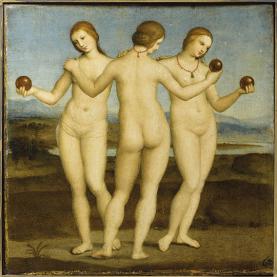Pomegranate, miracle fruit
The pomegranate’s botanical name Punica granatum shows it originates from the Roman Carthage (Tunisia). Its healing properties were already recognised in antiquity. Owing to its aesthetic shape, this delicious fruit features in various symbolic representations and its many seeds make it a symbol of fertility. Resembling an imperial orb, it stands for temporal power, while theologically, it represents the Church and priesthood.
Pomegranates have diverse cultural-religious significance, as a symbol of life and fertility owing to their many seeds but also as a symbol of power (imperial orb), blood and death. Pomegranates already symbolised fertility, beauty and eternal life, in Greek and Persian mythology. The Ancient Greeks considered a pomegranate a symbol of fertility and associated it with the goddesses Demeter, Persephone, Aphrodite, and Athena. The Bible only mentions pomegranates in the Old Testament. The hems of Jewish priestly vestments are decorated with a stylised form of this fruit (Ex. 28, 33f; 39, 24-26) and, as such, a pomegranate is a metaphor for the richness of the promised land of Israel (Deut. 8:8); in the Song of Solomon, Sulamith’s cheeks are compared to halves of a pomegranate (Cant. 4: 3).
In Christian symbolism (Hieronymus) the numerous seeds in this fruit represent the Church, unity in faith and a community of believers; in the same vein, a pomegranate appears in depictions of Mary as ‘the Mother of the Church’.
Pomegranates play an important role as a symbol of righteousness in Judaism, as they supposedly contain 613 seeds, which correspond to the 613 commandments of the Torah. Thus, at Rosh Hashanah (Jewish New Year), Jews eat this fruit one seed at a time, for as many wishes as possible to be fulfilled.
In Buddhism, pomegranates, peaches and lemons are considered three blessed kinds of fruit.
The Koran mentions a pomegranate three times (6:99, 6:141 and 55:68), representing, for example, the good things created by God, whether earthly fruit or that of Paradise, hence it is also sometimes referred to as the ‘apple of paradise’.
In the Middle Ages, the resemblance between a pomegranate and an imperial orb made it a symbol of power, probably a relic of Ancient Germanic representations. Albrecht Dürer painted two portraits of Emperor Maximilian I holding a pomegranate, to represent the imperial orb. Since then pomegranates have been seen as an aphrodisiac and are an ingredient of many love potions.
Ancient Persians already recognized the beneficial effect of pomegranates. Theophrast and Pliny recounted the different varieties and their medicinal properties. Late medieval books on plants described both the appearance and therapeutic effects of pomegranates. It is scientifically proven that pomegranates contain antioxidants, large quantities of flavonoids such as anthocyanins and quercetin, polyphenols, especially ellagitannins such as punicalagin and phenolic acids such as ellagic acid and gallic acid, with important functions for cell regulation. Pomegranates also contain potassium, vitamin A, C, E, calcium and iron.
Cooking the fruit yields a pitch-black ink. Pomegranate peel and juice have been used to dye Oriental carpets for centuries.
The name of the Spanish city of Granada is also linked with a pomegranate, which has featured in its coat of arms since the city was taken over by Christian rulers. A pomegranate with a cross is an attribute of St. John of God from Granada, who founded a hospital there in 1539. The Hospitalier Order of the Brothers of Saint John of God originated there and chose the pomegranate as their emblem.
The pomegranate (Punica granatum) belongs to the Lythraceae family of loosestrifes. Its botanical name Punica is derived from Latin punicus (Punic); it indicates its origins in the Roman province of Punia (Tunisia), whence the Romans imported pomegranates. The species name granatum (granum means grain in Latin) bears reference to the many seeds in its fruit. It is common in West to Middle Asia, but has also been cultivated since Antiquity in the Middle East and the Mediterranean – Iran is the biggest pomegranate producer and exporter worldwide.
The summer-green tree or shrub with lancet-shaped leaves grows up to 5 m tall, can live for up to 200 years and blossoms coral red in spring and summer. The delicious red-brown fruit, 5 to 12 cm in diameter, is shaped like an apple, crowned with sepals. It is considered a berry, since the pulp is not fleshy but does not lignify. The hard shell encloses chambers with individual angular seeds. Pomegranates are either eaten fresh or turned into cider.
Many cultures use pomegranates for decorative purposes. Originating from the Orient, this fruit became known across Italy and throughout Europe by featuring on rich fabrics and carpets. Pomegranates have been the subject of decorative patterns since the 15th century. Up to the 20th century, in German bourgeoisie, a dowry included a set of porcelain with an onion pattern on it, developed in the 18th century in Meissen. It is a little-known fact that this decoration does not actually show onions, but pomegranates and peaches – so, in truth, it should be called the pomegranate pattern.
Pomegranates also loaned their name to the grenade. In the Middle Ages this fruit was called malum granatum, because of its numerous kernels, and so shells filled with powder granules became known as ‘grenades’. German soldiers adopted the word around 1600 from the Italian granata and, during the Thirty Years’ War, it became part of vernacular language. Originally, grenades referred to hand-cast shells, but later the name was also used in reference to machine-fired ammunition.






